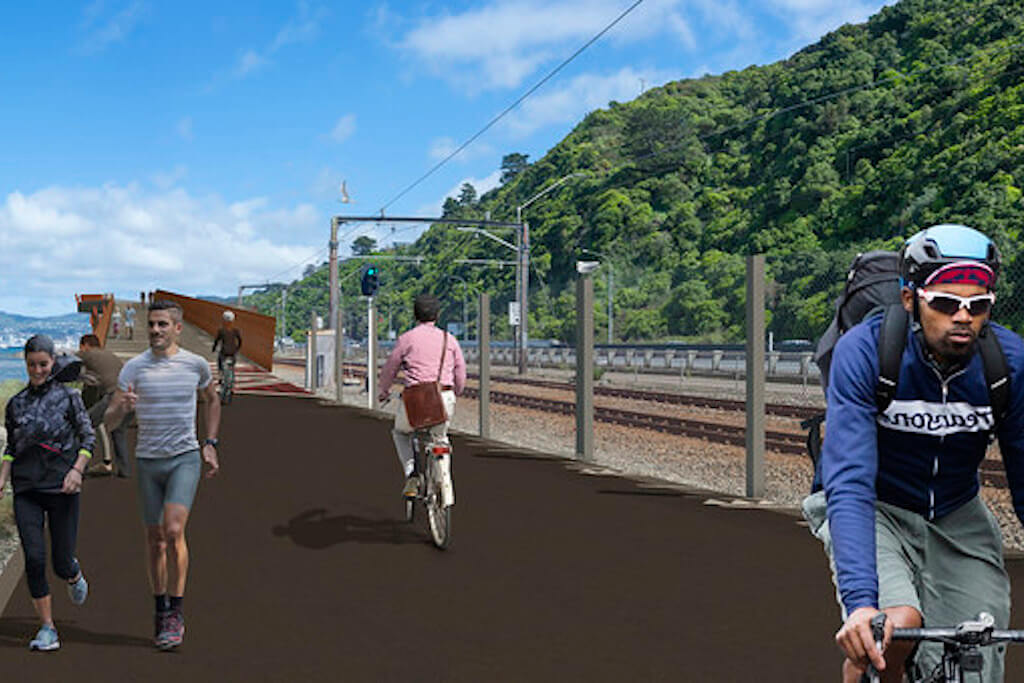Autumn Gear Guide
Find inspiration in our Gear Guide that will keep you out on your bike through wind or rain.
Download NowA couple of times a year, we garner feedback from readers to name and shame the worst bike lanes on the planet. And, there has been one in New Zealand that is just terrifying. Not just because it doesn’t even seem as wide as an average bicycle but it’s also that the speed limit on […]
A couple of times a year, we garner feedback from readers to name and shame the worst bike lanes on the planet. And, there has been one in New Zealand that is just terrifying. Not just because it doesn’t even seem as wide as an average bicycle but it’s also that the speed limit on the road is 100 km/h. But it is finally coming to a close.
It is State Highway 2, the main road stretching 10 km along the harbor from Wellington to Petone.
The Te Ara Tupua project aims to establish an active transport route connecting Wellington and Lower Hutt, New Zealand.
The project envisions a dedicated pathway designed for pedestrians, cyclists, and other non-motorized forms of transportation, providing a safe and scenic corridor for commuters and recreational users alike.
The trail aims to promote sustainable transportation options, enhance connectivity between these two vibrant cities, and encourage a healthier and more active lifestyle for residents and visitors. With its picturesque surroundings and strategic location, the Te Ara Tupua trail project holds the potential to become a valuable asset to the communities it serves, fostering a sense of community, promoting well-being, and celebrating the natural beauty of the region.


Renderings of the proposed trail system
Patrick Morgan is a bike advocate at Cycling Action Network, New Zealand’s national bicycle charity. He replied to our call for bad bike lane nominees with a photo of the road. It was frightening.
“When I lived in Petone I biked this road every day,” Morgan says. “There is no alternative route.”
Despite the paint and bike stencil, this is not a bike lane, he says.
“Paint is not protection. People on bikes are forced to cycle on a narrow strip between a drain and busy traffic doing up to 100 kmh,” Morgan explains. “Only the ‘strong and fearless’ bike here.”
Tragically, Morgan told Momentum that cyclist Brent Norriss was struck and killed by an inattentive driver in 2020. Mr. Norriss was planning to retire a few weeks later.
Jetesh Bhula, regional manager infrastructure delivery for the Waka Kotahi NZ Transport Agency managing the project, says Te Ara Tupua is a critical investment in resilience and will help ensure transport links and coastal protection between Wellington and Lower Hutt are strengthened and future-proofed. Bhula says the shared pathway also improves transport choices for residents and adds a new attraction to the Wellington region.
“People wanting to travel between the Hutt Valley and Wellington will no longer be restricted to rail, road or bus,” Bhula says. “The path will allow people to go by e-scooter, bike, or walk. It will let people reconnect with the coastline and help achieve our climate change targets when it joins other projects along a 17 km-long corridor between Wellington and the Hutt Valley.”
Is this a sign of good things to come for New Zealand? Maybe.
New Zealand, like so many countries, has what Morgan calls a “strong bias towards automobility,” which has resulted in a high number of traffic deaths. After years of inadequate planning and investment that favored private vehicle transportation and neglected biking and public transport, a shift is finally occurring.
“The transport agency and cities are on a long transition to low-carbon, safe streets,” Morgan says. “While some cities like Wellington and Christchurch are making good progress in building networks of bike lanes, New Zealand needs to move much faster to build streets that are safe and lovely. With effective advocates and enlightened leaders, we’re on our way.”
Find inspiration in our Gear Guide that will keep you out on your bike through wind or rain.
Download Now
Millions was spent on the Southern Motorway between Christchurch and Rolleston yet they did not build an accompanying cycle lane alongside it even though there is ample space. This is not future proofing or offering greener alternatives. A cycle lane would be used by walkers and runners as well as different types of electric bikes and scooters. As a result I drive a petrol powered car!
Comments are closed.